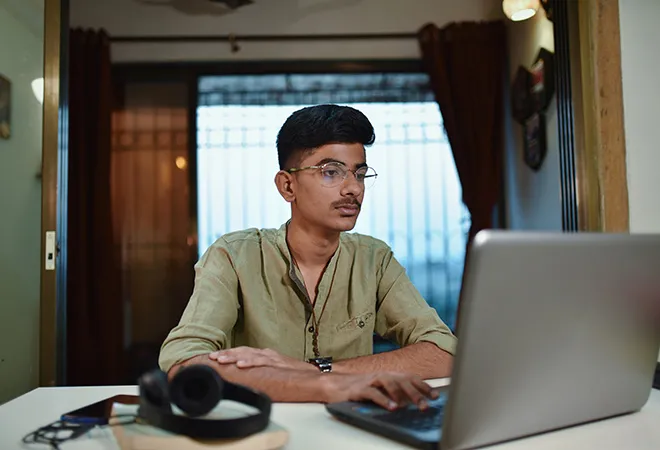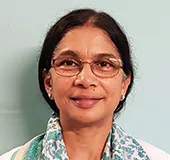
In response to the nationwide lockdown enforced since 24 March, state governments quickly took school education online in partnership with NGOs, foundations, and private sector EdTech companies. Collectively, they have pressed into service all communication channels at hand. This includes TV and DTH channels, radio broadcasts, WhatsApp and SMS groups, and the ubiquitous print medium; some even distributed textbooks in the new academic year. In contrast, the higher education sector appears to have been a lot less prepared to respond.
Experts such as Prof. Sahana Murthy of Indian Institute of Technology (IIT) Bombay are of the view that the sudden shift from face-to-face education to online platforms, termed as emergency remote teaching, is quite different from online education. The latter is a well-established and well-researched practice of instructional design — specifically for online delivery — that has been in use for several decades across countries, though not as much in Indian higher education institutes (HEIs). Universities and colleges will have to keep this difference in mind if they need to offer online classes in the coming semester, which may become necessary if the number of COVID-19 cases continue to rise.
India’s HEIs have been slow starters
The higher education sector in India has been slow to adopt online education and has therefore been relatively unprepared to cope with the sudden need for online teaching. As of 30 January 2020, there were only seven HEIs that had applied for and received permission to run online programmes under the UGC’s 2018 regulations on online courses or programmes. Majority of the 40,000 HEIs did not have permission to run online courses pre-COVID. Thus, it was only natural that they were not prepared to switch to the synchronous delivery of online classes when invited to do so by governments. It was only in mid-May that the finance minister announced that the top 100 institutions in the National Institutional of Ranking Framework (NIRF) would be automatically allowed to start online programmes. But, this measure only benefits a small sliver of students.
The higher education sector in India has been slow to adopt online education and has therefore been relatively unprepared to cope with the sudden need for online teaching.
Just two days after the lockdown, the UGC shared a list of the government’s ICT initiatives and resources that students could use free of charge to continue learning under lockdown, including courses on SWAYAM and the National Digital Library. More recently, students have also been allowed to start a second degree, either online or through open and distance learning mode, along with their regular degree. While these are excellent moves that can benefit students even beyond the COVID period, it is still a case of too little too late.
Unprepared for the online shift
One of the key challenges of providing more online courses is the fact that many faculty members in higher education are not trained and therefore, not prepared to conduct classes online. Planning and preparation for a fully online course can take as long as six to nine months and not a few weeks that is being afforded by the pandemic. Early adopters and experienced faculty members will need to provide a considerable degree of handholding to colleagues within their own institutions as well as outside, as pointed out by Dr. Shakila Shamsu (Officer on Special Duty, New Education Policy, Ministry of Human Resource Development) in a webinar organised by ORF. Faculty members typically become comfortable with teaching online during the second or third edition of their courses. As such, they need to be encouraged to make a beginning. They can be assisted by tech savvy teaching assistants (TAs) — an approach India is yet to adopt, even though it is used extensively in universities abroad. TAs also run chatrooms and peer learning sessions for students which are very beneficial and promote learning.
Online education is still perceived by many faculty members and students as being inferior to face-to-face education. It is indeed unlikely to replace campus-based education among those who have a choice between them. However, well designed online courses that are based on instructional design principles adapted to the characteristics of the medium, such as the ability to record and asynchronously replay the audio/video clips, have made online education an invaluable supplement to regular university education, as proven by the success of Coursera, edX, and others. The delay in the start of the coming semester gives HEIs and faculty an opportunity to prepare for quality online programmes.
Online education is still perceived by many faculty members and students as being inferior to face-to-face education. It is indeed unlikely to replace campus-based education among those who have a choice between them.
As pointed out by Prof. V. Sridhar of IIIT Bangalore at an ORF webinar, there is also an economic argument for proliferating online courses that is borne out by the success of these large online education platforms. Online courses are a lot less expensive and these platforms have many times more students than any individual university or college. India would do well to use the pandemic and the increased awareness on online education as an opportunity, to get its institutions to think about the long-term opportunities that it can offer. IIT Bombay has recently put out a self-paced course on online teaching for college instructors. More such resources need to be prepared and shared as part of a larger handholding effort, so that many more courses can be created, especially also in Indian languages.
Accessibility issues
All the discussion on emergency remote teaching online education is predicated on an important assumption — that students have Internet and suitable devices such as computers, laptops etc., to access online education comfortably. Unfortunately, this premise fails both in the case of school as well as higher education. Unlike schools, which tend to draw their students from local neighbourhoods, HEIs tend to cast a wider net, attracting students from different states and also from rural areas. Therefore most HEIs are affected, since many students who returned home after the lockdown do not have adequate Internet access. Data from the NSS on Education, 75th Round, indicates that 24 percent (42 percent urban and 15 percent rural) households have Internet access, and just 11 percent (4.4 percent rural and 23.4 percent urban) households own computers (not counting smartphones). According to a recent IAMAI report, India now has over 500 million Internet users, of which 433 million are over the age of 12, 65 percent of them male. The digital divide is corroborated by surveys conducted by premier universities such as University of Hyderabad, in which only 37 percent students said they were able to access online classes and 90 percent preferred to view lectures offline. Even at the IITs, 10 percent or more students said they cannot download study material or take online courses due to connectivity issues, inadequate data plans and so on.
In the longer term, the Central and state governments must commit to providing broadband access and suitable devices to all educational institutions.
Results from a recent survey by the ranking agency Quacquarelli Symonds (QS) presented by their Regional Director, Dr. Ashwin Fernandes, at the ORF webinar, show that 72.6 percent of over 7,500 students surveyed use mobile phone hotspots to access the Internet — a solution that is considered to be a ‘low-tech’ by UNESCO. Only 15.87 percent students had broadband access, but even these respondents faced poor connectivity, power availability, and signal issues. Of those using mobile hotspots, nearly 97 percent faced poor connectivity or signal issues. To put these figures into perspective, it is important to remember that only 30 percent of the Indian population has access to smartphones. The use of TV channels for education — a technology with the deepest reach — is also not a solution, given that only 67 percent of households have access to it.
Sharing of smartphones, laptops, TV, etc. is being tried; however, even if a single student is left behind, the move to online teaching will remain unfair to them. In the longer term, the Central and state governments must commit to providing broadband access and suitable devices to all educational institutions. BharatNet, a project to provide rural broadband access to 2.5 lakh Gram Panchayats in the country has been underway since 2011, but the last mile connectivity has not become operational in most locations. When it does — and this must be prioritised — it can support rural communities and students with high quality bandwidth, not just for education, but also for use in health services, agriculture, livelihoods and more.
Until then, all faculty members in higher education will have to make use of whatever means they have to stay in touch with their students and use their own ingenuity to keep them motivated and learning during this time. This may well prove be an opportunity to reimagine higher education, provided we are able to set aside conventional thinking regarding teaching, learning and assessment, at least during this period.
The views expressed above belong to the author(s). ORF research and analyses now available on Telegram! Click here to access our curated content — blogs, longforms and interviews.




 PREV
PREV


